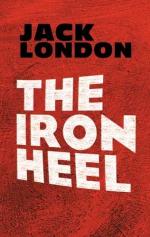Simultaneously with the destruction of the Grangers came the revolt of the coal miners. It was the expiring effort of organized labor. Three-quarters of a million of miners went out on strike. But they were too widely scattered over the country to advantage from their own strength. They were segregated in their own districts and beaten into submission. This was the first great slave-drive. Pocock* won his spurs as a slave-driver and earned the undying hatred of the proletariat. Countless attempts were made upon his life, but he seemed to bear a charmed existence. It was he who was responsible for the introduction of the Russian passport system among the miners, and the denial of their right of removal from one part of the country to another.
* Albert Pocock, another of the notorious strike-breakers of earlier years, who, to the day of his death, successfully held all the coal-miners of the country to their task. He was succeeded by his son, Lewis Pocock, and for five generations this remarkable line of slave-drivers handled the coal mines. The elder Pocock, known as Pocock I., has been described as follows: “A long, lean head, semicircled by a fringe of brown and gray hair, with big cheek-bones and a heavy chin, . . . a pale face, lustreless gray eyes, a metallic voice, and a languid manner.” He was born of humble parents, and began his career as a bartender. He next became a private detective for a street railway corporation, and by successive steps developed into a professional strikebreaker. Pocock V., the last of the line, was blown up in a pump-house by a bomb during a petty revolt of the miners in the Indian Territory. This occurred in 2073 A.D.
In the meantime, the socialists held firm. While the Grangers expired in flame and blood, and organized labor was disrupted, the socialists held their peace and perfected their secret organization. In vain the Grangers pleaded with us. We rightly contended that any revolt on our part was virtually suicide for the whole Revolution. The Iron Heel, at first dubious about dealing with the entire proletariat at one time, had found the work easier than it had expected, and would have asked nothing better than an uprising on our part. But we avoided the issue, in spite of the fact that agents-provocateurs swarmed in our midst. In those early days, the agents of the Iron Heel were clumsy in their methods. They had much to learn and in the meantime our Fighting Groups weeded them out. It was bitter, bloody work, but we were fighting for life and for the Revolution, and we had to fight the enemy with its own weapons. Yet we were fair. No agent of the Iron Heel was executed without a trial. We may have made mistakes, but if so, very rarely. The bravest, and the most combative and self-sacrificing of our comrades went into the Fighting Groups. Once, after ten years had passed, Ernest made a calculation from figures furnished by the chiefs of the Fighting Groups, and his conclusion was that the average life of a man or woman after becoming a member was five years. The comrades of the Fighting Groups were heroes all, and the peculiar thing about it was that they were opposed to the taking of life. They violated their own natures, yet they loved liberty and knew of no sacrifice too great to make for the Cause.*




